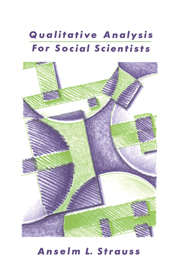Book contents
- Frontmatter
- Contents
- Preface
- 1 Introduction
- 2 Two illustrations
- 3 Codes and coding
- 4 Seminar on open coding
- 5 Memos and memo writing
- 6 Team meetings and graphic representations as memos
- 7 Excerpts that illustrate common problems
- 8 Integrative diagrams and integrative sessions
- 9 Integrative mechanisms: diagrams, memo sequences, writing
- 10 Presenting case materials: data and interpretations
- 11 Grounded formal theory: awareness contexts
- 12 Reading and writing research publications
- 13 Questions and answers
- 14 Research consultations and teaching: guidelines, strategies, and style
- Epilogue
- Appendix Discovering new theory from previous theory
- References
- Author index
- Subject index
7 - Excerpts that illustrate common problems
Published online by Cambridge University Press: 26 January 2010
- Frontmatter
- Contents
- Preface
- 1 Introduction
- 2 Two illustrations
- 3 Codes and coding
- 4 Seminar on open coding
- 5 Memos and memo writing
- 6 Team meetings and graphic representations as memos
- 7 Excerpts that illustrate common problems
- 8 Integrative diagrams and integrative sessions
- 9 Integrative mechanisms: diagrams, memo sequences, writing
- 10 Presenting case materials: data and interpretations
- 11 Grounded formal theory: awareness contexts
- 12 Reading and writing research publications
- 13 Questions and answers
- 14 Research consultations and teaching: guidelines, strategies, and style
- Epilogue
- Appendix Discovering new theory from previous theory
- References
- Author index
- Subject index
Summary
In this chapter, we reproduce fragments of seminar sessions, and in one instance the summary of a student–teacher consultation. Their presentation here is designed to illuminate, beyond the materials in preceding chapters, common problems encountered in learning–or doing–grounded theory analysis, whether by students in a seminar or even by experienced researchers when confronting the problem of analysis during a new project, perhaps with new kinds of data and datacollecting experiences. (Some of these common problems are found in any style of qualitative analysis, not only in the grounded theory mode.) The teacher's strategies for helping to surmount these problems are also reflected in the cases given below.
Among the stumbling blocks to effective analysis, at various points in the learning process or during the evolving research project, are the following:
learning to persist, line by line
learning to move from description to analysis via dimensionalizing
breaking through to analytic focus when flooded with experiential data
asking for too much data
illustrating the connections between macro- and microconditions and consequences
determining the central issue in the study
filling a hole in the integrative diagram.
Case 1
A rudimentary line-by-line analysis
As noted earlier, an initial step in teaching grounded theory analysis is a close examination of the interview, fleldnote, or other document, done quite literally line by line, even by a word-by-word scrutiny of the opening lines. (See Case 1, chapter on coding, for an example.) This gives the fledgling analyst a vivid sense of what can be gotten from patient, detailed scrutiny. Watching the instructor do this is one thing, doing it by oneself is another.
- Type
- Chapter
- Information
- Qualitative Analysis for Social Scientists , pp. 151 - 169Publisher: Cambridge University PressPrint publication year: 1987

